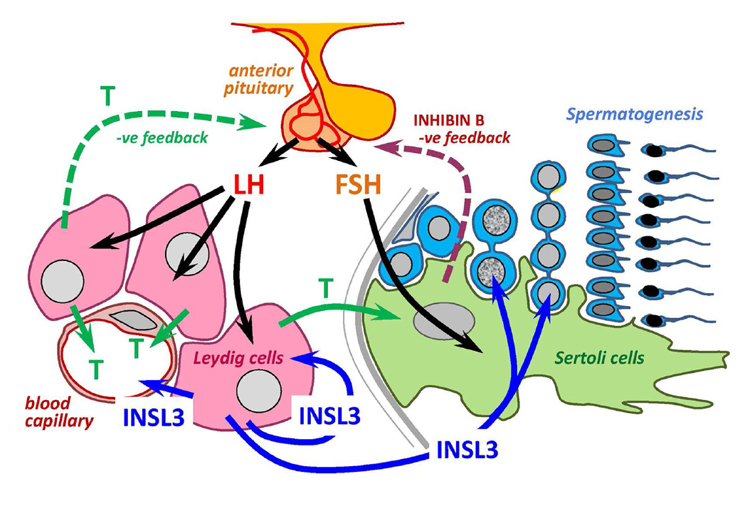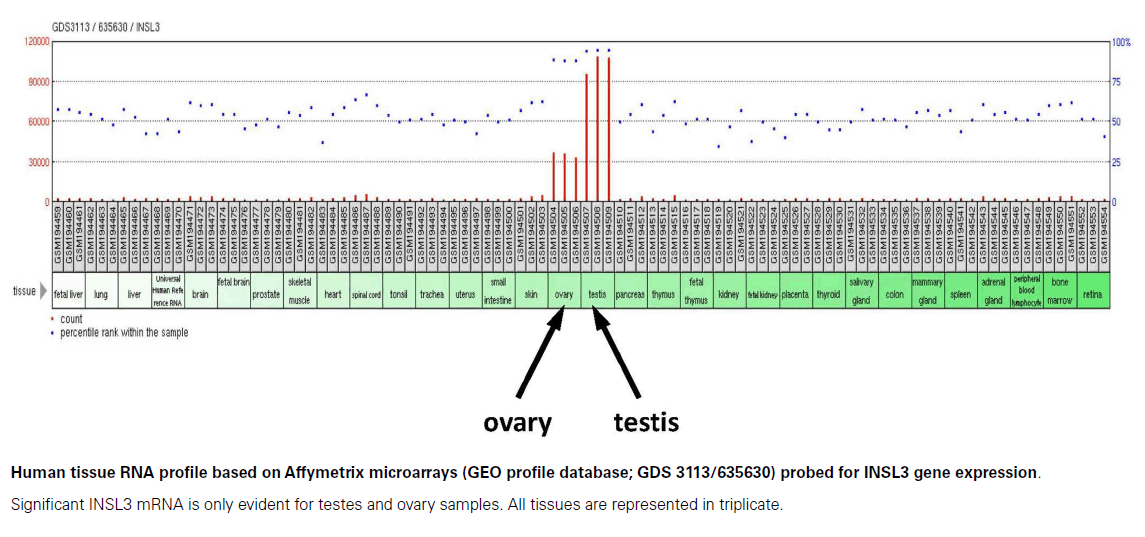
Scheme to show the relationship between INSL3/RXFP2 system and testosterone as endpoint effectors of the HPG axis within the testis. Arrows are directed only to cells where there are known to be specific cognate receptors. Sertoli cells are the most representative cells of the prepubertal testis. INSL3 is a testicular hormone secreted during fetal/neonatal period and after puberty. INSL3 arises as a biomarker of Leydig cell functionality.
Figure from: Ivell R. et al., Front Endocrinol (Lausanne). 2014 Jan. Insulin-Like Factor 3 and the HPG Axis in the Male.

Figure from: Ivell R. et al., Front Endocrinol (Lausanne). 2014 Jan. Insulin-Like Factor 3 and the HPG Axis in the Male.
Context: Insulin-like factor 3 (INSL3) is a testicular hormone secreted during fetal life, the neonatal period, and after puberty.
Objective: To measure INSL3 levels in a large series of men with congenital hypogonadotropic hypogonadism (CHH)/ Kallmann syndrome (KS), in order to assess its diagnostic value and to investigate its regulation.
Patients: We studied 281 CHH/KS patients (91 untreated, 96 receiving T, and 94 receiving combined gonadotropin therapy [human chorionic gonadotropin, hCG, and FSH]) and 72 age-matched healthy men.
Methods: Serum INSL3 was immunoassayed with a validated RIA (Phoenix’s cat. # RK-035-27).
Results: Mean (±SD) INSL3 levels (pg/mL) were 659 ± 279 in controls and lower (60 ± 43; P < .001) in untreated CHH/KS patients, with no overlap between the two groups, when the threshold of 250 pg/mL was used. Basal INSL3 levels were lower in both untreated CHH/KS men with cryptorchidism than in those with intrascrotal testes and in patients with testicular volumes below 4 mL. Significant positive correlations between INSL3 and both serum total T and LH levels were observed in untreated CHH/KS. Mean INSL3 levels remained low in T-treated CHH/KS patients and were significantly higher in men receiving combined hCG-FSH therapy (P < .001), but the increase was lower cryptorchid patients. FSH-hCG combination therapy or hCG monotherapy, contrary to T and FSH monotherapies, significantly increased INSL3 levels in CHH/KS.
Conclusions: INSL3 is as sensitive a marker as T for the evaluation of altered Leydig cell function in CHH/KS patients. INSL3 levels correlate with LH levels in CHH/KS men showing, together with the rise in INSL3 levels during hCG therapy, that INSL3 secretion seems not constitutively secreted during adulthood but is dependence on pituitary LH.

| INSL3 levels were determined using Phoenix Pharmaceutical's INSL3 RIA Kit (# RK-035-27). |

Trabado S, Maione L, Bry-Gauillard H et al., J Clin Endocrinol Metab. 2014 Feb;99(2):E268-75. doi: 10.1210/jc.2013-2288. Epub 2013 Nov 15.


